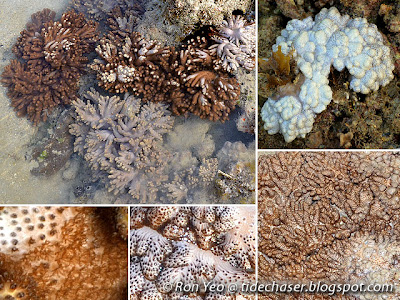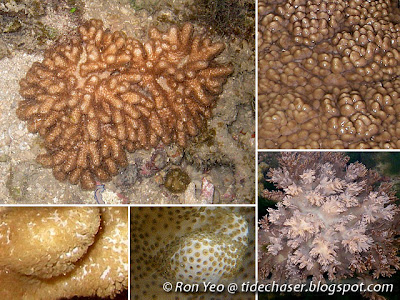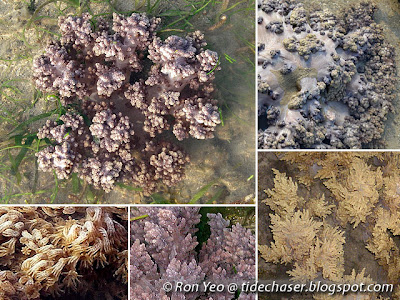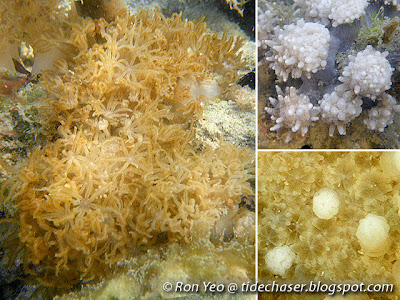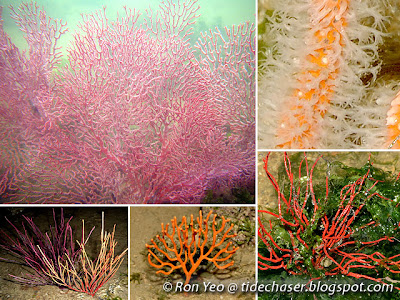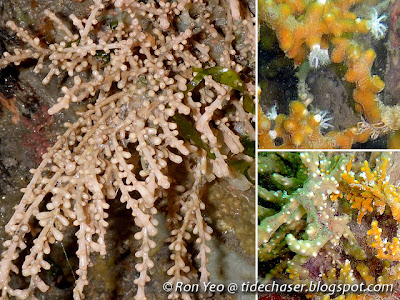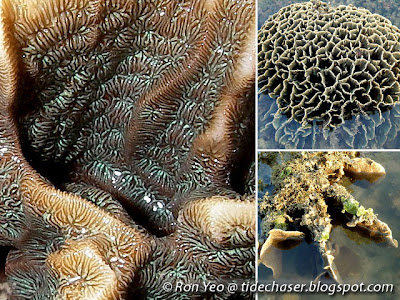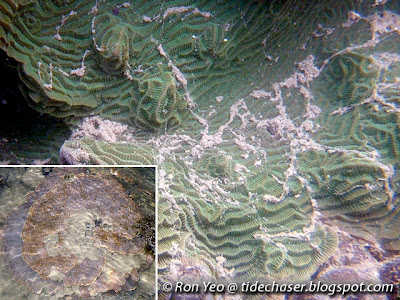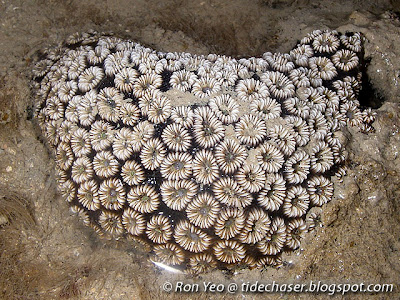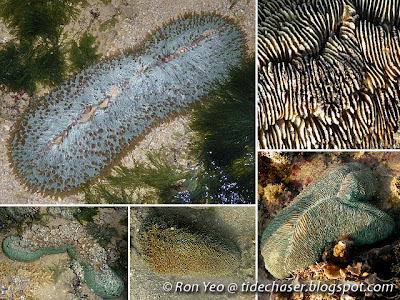I started doing nature guiding in 2005, and I could still remember that at that time, training for guides was quite location-specific - we discussed the standard operation procedures for the location, share about the background of the location, and learn about the flora and fauna found there. Although we also discussed about some of the guiding techniques, it was more of the experienced guides highlighting what they thought were important. While the techniques were useful, they were essentially what the guides could think of at that point in time, and hence we had to learn a lot of things on our own through trial-and-error. At that time, I have not even heard what nature interpretation is.
I started assisting with the training of nature guides in late 2006, and become a main trainer in 2007. The training content I used were consolidated from the experiences I gained as an active nature guide and from other experienced guides, as I tried to design a proper structure for training guides, and adopt a more systematic approach for the whole process.
It was only in recent years that I heard about nature interpretation, and started reading up about it. It felt weird to think that to some extend I had been trying to reinvent the wheel last time, though what I had come up with previously was more specific to Singapore, or at least to a particular nature spot. After finding out more about the experts' views on nature interpretation, I also realised then that there are definitely several good practices that are quite universal for most nature walks. It will be useful to train new guides with these universal good practices, and at the same time, include some practices that will be more relevant to the local scene.
So in this blog entry, I will attempt to share the things I have learned, the experiences I have gained, and what I personally feel is important with regards to nature interpretation.
A) What is Nature Interpretation?
Personally, I feel it is a communication process to facilitate the understanding of the various biotic and abiotic components of our natural environment and the relationships between them.
"Facilitate" is a key word here, as I feel it is not just about communicating what you know with the audience, but create a platform to allow the communication to take place. In other words, while in most cases the information may come from the nature guide, it is also possible that the information may come from a member of the audience. Hence, the guide should ensure that there is proper interaction and not a one way communication, and must also be humble enough to accept that sometimes the audience may know more about a particular topic than the guide.
B) Role of a Nature Interpreter/Guide
The interpreter will have to facilitate the communication of ideas, feelings and values so as to provoke audiences to do their own thinking and develop their own understanding of nature and appreciate the importance of nature, hence be inspired to play a part in nature conservation.
He/she also have to be a role model for the participants. Actions speak louder than words, and hence if the guide shows that he/she really care about nature, the audience will be more positively influence. For example, the guide should not make unnecessary noises and end up disturbing the wildlife, and also, should not feed animals or rescue prey from predators, but let nature takes its course.
It is also important that he/she ensures the safety and comfort of the audience, and that the entire programme is smoothly run.
C) Guiding is MAD!
A nature interpreter will need to manage the Message, the Audience, and the Delivery of the message during a nature walk.
D) Crafting the Message
The message is what the guide will be saying to the participants. A beginner nature interpreter should always write a script for the messages he/she will be conveying for a walk, and the script should be written as if he/she is talking to the participants, i.e. not in point form. Writing a script will give the interpreter an idea of how exactly he/she should do the commentary, and serves as a backup if the beginner guide gets stage fright. Experienced guides can also look at the script and give tips on how it can be improved.
The message should strive to be EROTIC - Entertaining, Relevant, Organised, Themed, Inspiring and Conversational.
Entertaining - When the participants find the nature walk enjoyable, there will be a higher chance that they will like the nature spot better, remember what they have learned during the walk, and more motivated to want protect the nature spot. As such, it is usually a good idea to include some jokes and topics most people are interested with (e.g. food and sex) to ensure that the participants are not bored. However, while jokes are to be included, the interpreter should avoid putting an organism in a bad light, e.g. saying it is disgusting or evil etc, or the participants may subconsciously develop negative emotions for nature.
Relevant - Avoid confusing the participants by talking about things that are not relevant to the topic. For example, I have witnessed a guide showing the participants a living snail, and ended up spending most of the time talking about hermit crabs occupying dead snails' shells. There was another occasion when I overheard a guide talking about vampire bats when the subject was a fruit bat. Unless the participants ask (which the guide may choose to give a short reply), the guide should focus on what is in front of them. And obviously, the script prepared by the guide should be regarding the flora and fauna that can usually be found along the chosen nature trail. While explaining difficult concepts, it is also useful to use analogies relevant to the participants, i.e. something that they are familiar with, so that they can relate better to them.
Organised - A message should be coherent, or else the participants will have a hard time trying to understand what the guide has said. Start the story with a statement that will draw the participants' attention to the organism. E.g. "We are really lucky to see this today! This is a XXX" or "Does anybody know what this is?" After that, elaborate 2 or 3 interesting topics regarding the subject matter, i.e. the plant, animal etc. The guide should avoid trying to show off how much he/she knows, or the participants may be put off. Ensure that the message flows smoothly, and a complete picture of every topic is presented. The message should have a proper closure, so that the participants got the signal that it has ended and they can move on.
Themed - The theme refers to the core idea(s) for the commentaries, and it is very important because it determines what the guide wants the participants to know, what he/she hope they will feel, and how he/she hope they will behave during and after the activity. A nature walk may have more than one theme. For example, if the theme is biodiversity, the guide will try to introduce more flora and fauna with shorter commentaries, but if the theme is conservation then the guide will spend more time on the conservation status of the flora and fauna, and how are they threatened, and what can be done to conserve them.
Inspiring - Singapore has very few nature spots left, and hence as far as possible we hope to inspire the participants to be involved with conservation. The guide can ask thought-provoking questions, e.g. what will happen if a particular plant/animal goes extinct? Will we lose a potential cure for some diseases? The guide should lead by example to care for the environment (actions speak louder than words!), but should never promote his/her personal achievements as some participants may be put off. The guide can also give suggestions on the little things everyone can do to contribute to conservation.
Conversational - The guide should avoid talking like he/she is giving a documentary commentary, but more like talking with a friend. The message script should hence also be written as such, and not in the form of an essay or in point form. If the commentaries are made like a speech, the personal touch will be absent, and it will be harder to get the participants to trust the guide and feel for the things that are discussed. Similarly, the guide should not be talking down in a superior tone (i.e. I know more than you). A few simple questions should be added to encourage the participants to interact and express their views. Questions requiring "Yes" or "No" answers make it easier for participants to answer. Questions can also be used to draw the participants' attention, and the response can be an action rather than a verbal response. E.g. "Can you see the tiny hair on XXX's back?"
E) Managing the Audience
The audience refers to the participants, and it is important to manage the audience well to ensure that a nature walk is a success. And really, managing the audience is a SCAM - the guide needs to ensure their Safety and Comfort, then try to get their Attention, and watch out for Misbehaviours.
Safety - It is always important to conduct a safety briefing and ensure that the audience follows instructions. As a usual rule, the participants should not touch anything along the trail without permission, as some of the things may be dangerous, e.g. poisonous plant, venomous animals etc. It is also important to remind them not to wander off the trail, as they may be causing damage to the nature area, and also there could be dangers (hidden holes, snakes etc). Singapore is usually quite hot, and hence it is good to remind them to drink water. Also, the guide should keep a look out for anyone not feeling well. The guide should also take note of bad weathers, and must be familiar with the evacuation procedures in case any emergencies.
Comfort - After ensuring the safety of the audience, the guide must ensure that their comfort as far as being realistic, since they my get very restless if they feel uncomfortable. For example, the guide should be the one facing the sun, not the participants. If the trail has biting insects, the audience should be reminded to spray insect repellent before they enter the trail. It is also important not to force participants to touch or taste things if they don’t want to. Sometimes, there could be delays in the trip, and hence the guide should communicate the reasons for the delay with the audience, and keep them occupied.
Attention - When the audience feel safe and comfortable, it will be easier to get their attention. The guide should take note of environmental noises (airplane, factory etc), and move away or wait for the sound to subside before continuing with the commentary. The message should also be tailored to the audience to get their attention. For example, the guide can also use analogies relevant to the audience's experience to allow them to relate to the subject matter better. It is also important not to use scientific or difficult words for a public group or they will not be able to understand the commentary. Also, the guide can choose topics that are more relevant to the type of audience, e.g. joke about reproduction adaptations with only adults; use examples from kids programmes when dealing with children; use local examples such as what can be eaten or used for local groups, or compare with foreign customs for foreign groups etc. It is hence important to interact with the audience to know what they want and adjust accordingly. Depending on the interest level, the guide may adjust the length of the message.
Misbehaviours - It is important to manage misbehaving participants, and they can affect the other participants. Examples of misbehaviours include: visitors doing anything dangerous; asking irrelevant questions repeatedly; asking too many questions and delay the trip; and wandering off the trail etc. to manage such participants, the guide can: remind them nicely to behave themselves; inform them time is running out, and you will answer the questions at the end one-to-one; or in cases which the participant refuses to improve his/her behaviour, inform the organiser, who can remove him/her from the group so that the walk can proceed smoothly and the mood of the other participants will not be spoilt.
F) Delivering the Message
When a guide delivers his/her commentary, he/she is actually communicating using both verbal communication and nonverbal communication.
Verbal Communication - This is communication using words i.e. the spoken message, which was what we have covered under the section Crafting the Message. But it is important to note that the scripted message is just a reference, and as mentioned under the section Managing the Audience, the actual verbal message delivered should be adjusted to match the type of audience.
Nonverbal Communication - This refers to communication without using words, which includes the use of the various Senses, Nonverbal aspects of talking, Attire, and Body language, otherwise shortened as SNAB.
G) Conclusion
The above are just my 2 cents' worth of what I feel is important while doing nature interpretation. I will think that most experienced nature guides will have their own ideas about what makes a good nature guide, and hence I will assume that there will be guides who disagree with the above techniques. But I guess this should still serve as a good reference for beginner guides! All roads lead to Rome, and as long as the audience has a positive experience and their understanding and appreciation of nature are improved after the guided walk, I would think the nature interpreter has done a good job! :)
I started assisting with the training of nature guides in late 2006, and become a main trainer in 2007. The training content I used were consolidated from the experiences I gained as an active nature guide and from other experienced guides, as I tried to design a proper structure for training guides, and adopt a more systematic approach for the whole process.
It was only in recent years that I heard about nature interpretation, and started reading up about it. It felt weird to think that to some extend I had been trying to reinvent the wheel last time, though what I had come up with previously was more specific to Singapore, or at least to a particular nature spot. After finding out more about the experts' views on nature interpretation, I also realised then that there are definitely several good practices that are quite universal for most nature walks. It will be useful to train new guides with these universal good practices, and at the same time, include some practices that will be more relevant to the local scene.
So in this blog entry, I will attempt to share the things I have learned, the experiences I have gained, and what I personally feel is important with regards to nature interpretation.
A) What is Nature Interpretation?
Personally, I feel it is a communication process to facilitate the understanding of the various biotic and abiotic components of our natural environment and the relationships between them.
"Facilitate" is a key word here, as I feel it is not just about communicating what you know with the audience, but create a platform to allow the communication to take place. In other words, while in most cases the information may come from the nature guide, it is also possible that the information may come from a member of the audience. Hence, the guide should ensure that there is proper interaction and not a one way communication, and must also be humble enough to accept that sometimes the audience may know more about a particular topic than the guide.
B) Role of a Nature Interpreter/Guide
The interpreter will have to facilitate the communication of ideas, feelings and values so as to provoke audiences to do their own thinking and develop their own understanding of nature and appreciate the importance of nature, hence be inspired to play a part in nature conservation.
He/she also have to be a role model for the participants. Actions speak louder than words, and hence if the guide shows that he/she really care about nature, the audience will be more positively influence. For example, the guide should not make unnecessary noises and end up disturbing the wildlife, and also, should not feed animals or rescue prey from predators, but let nature takes its course.
It is also important that he/she ensures the safety and comfort of the audience, and that the entire programme is smoothly run.
C) Guiding is MAD!
A nature interpreter will need to manage the Message, the Audience, and the Delivery of the message during a nature walk.
D) Crafting the Message
The message is what the guide will be saying to the participants. A beginner nature interpreter should always write a script for the messages he/she will be conveying for a walk, and the script should be written as if he/she is talking to the participants, i.e. not in point form. Writing a script will give the interpreter an idea of how exactly he/she should do the commentary, and serves as a backup if the beginner guide gets stage fright. Experienced guides can also look at the script and give tips on how it can be improved.
The message should strive to be EROTIC - Entertaining, Relevant, Organised, Themed, Inspiring and Conversational.
Entertaining - When the participants find the nature walk enjoyable, there will be a higher chance that they will like the nature spot better, remember what they have learned during the walk, and more motivated to want protect the nature spot. As such, it is usually a good idea to include some jokes and topics most people are interested with (e.g. food and sex) to ensure that the participants are not bored. However, while jokes are to be included, the interpreter should avoid putting an organism in a bad light, e.g. saying it is disgusting or evil etc, or the participants may subconsciously develop negative emotions for nature.
Relevant - Avoid confusing the participants by talking about things that are not relevant to the topic. For example, I have witnessed a guide showing the participants a living snail, and ended up spending most of the time talking about hermit crabs occupying dead snails' shells. There was another occasion when I overheard a guide talking about vampire bats when the subject was a fruit bat. Unless the participants ask (which the guide may choose to give a short reply), the guide should focus on what is in front of them. And obviously, the script prepared by the guide should be regarding the flora and fauna that can usually be found along the chosen nature trail. While explaining difficult concepts, it is also useful to use analogies relevant to the participants, i.e. something that they are familiar with, so that they can relate better to them.
Organised - A message should be coherent, or else the participants will have a hard time trying to understand what the guide has said. Start the story with a statement that will draw the participants' attention to the organism. E.g. "We are really lucky to see this today! This is a XXX" or "Does anybody know what this is?" After that, elaborate 2 or 3 interesting topics regarding the subject matter, i.e. the plant, animal etc. The guide should avoid trying to show off how much he/she knows, or the participants may be put off. Ensure that the message flows smoothly, and a complete picture of every topic is presented. The message should have a proper closure, so that the participants got the signal that it has ended and they can move on.
Themed - The theme refers to the core idea(s) for the commentaries, and it is very important because it determines what the guide wants the participants to know, what he/she hope they will feel, and how he/she hope they will behave during and after the activity. A nature walk may have more than one theme. For example, if the theme is biodiversity, the guide will try to introduce more flora and fauna with shorter commentaries, but if the theme is conservation then the guide will spend more time on the conservation status of the flora and fauna, and how are they threatened, and what can be done to conserve them.
Inspiring - Singapore has very few nature spots left, and hence as far as possible we hope to inspire the participants to be involved with conservation. The guide can ask thought-provoking questions, e.g. what will happen if a particular plant/animal goes extinct? Will we lose a potential cure for some diseases? The guide should lead by example to care for the environment (actions speak louder than words!), but should never promote his/her personal achievements as some participants may be put off. The guide can also give suggestions on the little things everyone can do to contribute to conservation.
Conversational - The guide should avoid talking like he/she is giving a documentary commentary, but more like talking with a friend. The message script should hence also be written as such, and not in the form of an essay or in point form. If the commentaries are made like a speech, the personal touch will be absent, and it will be harder to get the participants to trust the guide and feel for the things that are discussed. Similarly, the guide should not be talking down in a superior tone (i.e. I know more than you). A few simple questions should be added to encourage the participants to interact and express their views. Questions requiring "Yes" or "No" answers make it easier for participants to answer. Questions can also be used to draw the participants' attention, and the response can be an action rather than a verbal response. E.g. "Can you see the tiny hair on XXX's back?"
E) Managing the Audience
The audience refers to the participants, and it is important to manage the audience well to ensure that a nature walk is a success. And really, managing the audience is a SCAM - the guide needs to ensure their Safety and Comfort, then try to get their Attention, and watch out for Misbehaviours.
Safety - It is always important to conduct a safety briefing and ensure that the audience follows instructions. As a usual rule, the participants should not touch anything along the trail without permission, as some of the things may be dangerous, e.g. poisonous plant, venomous animals etc. It is also important to remind them not to wander off the trail, as they may be causing damage to the nature area, and also there could be dangers (hidden holes, snakes etc). Singapore is usually quite hot, and hence it is good to remind them to drink water. Also, the guide should keep a look out for anyone not feeling well. The guide should also take note of bad weathers, and must be familiar with the evacuation procedures in case any emergencies.
Comfort - After ensuring the safety of the audience, the guide must ensure that their comfort as far as being realistic, since they my get very restless if they feel uncomfortable. For example, the guide should be the one facing the sun, not the participants. If the trail has biting insects, the audience should be reminded to spray insect repellent before they enter the trail. It is also important not to force participants to touch or taste things if they don’t want to. Sometimes, there could be delays in the trip, and hence the guide should communicate the reasons for the delay with the audience, and keep them occupied.
Attention - When the audience feel safe and comfortable, it will be easier to get their attention. The guide should take note of environmental noises (airplane, factory etc), and move away or wait for the sound to subside before continuing with the commentary. The message should also be tailored to the audience to get their attention. For example, the guide can also use analogies relevant to the audience's experience to allow them to relate to the subject matter better. It is also important not to use scientific or difficult words for a public group or they will not be able to understand the commentary. Also, the guide can choose topics that are more relevant to the type of audience, e.g. joke about reproduction adaptations with only adults; use examples from kids programmes when dealing with children; use local examples such as what can be eaten or used for local groups, or compare with foreign customs for foreign groups etc. It is hence important to interact with the audience to know what they want and adjust accordingly. Depending on the interest level, the guide may adjust the length of the message.
Misbehaviours - It is important to manage misbehaving participants, and they can affect the other participants. Examples of misbehaviours include: visitors doing anything dangerous; asking irrelevant questions repeatedly; asking too many questions and delay the trip; and wandering off the trail etc. to manage such participants, the guide can: remind them nicely to behave themselves; inform them time is running out, and you will answer the questions at the end one-to-one; or in cases which the participant refuses to improve his/her behaviour, inform the organiser, who can remove him/her from the group so that the walk can proceed smoothly and the mood of the other participants will not be spoilt.
F) Delivering the Message
When a guide delivers his/her commentary, he/she is actually communicating using both verbal communication and nonverbal communication.
Verbal Communication - This is communication using words i.e. the spoken message, which was what we have covered under the section Crafting the Message. But it is important to note that the scripted message is just a reference, and as mentioned under the section Managing the Audience, the actual verbal message delivered should be adjusted to match the type of audience.
Nonverbal Communication - This refers to communication without using words, which includes the use of the various Senses, Nonverbal aspects of talking, Attire, and Body language, otherwise shortened as SNAB.
- Senses - The guide should try to use all the five senses to communicate with the audience. For example, he/she can listen out for bird or insect calls, look out for movements or camouflaging animals, smell the herbs and spices, touch and feel the texture of leaves, and taste edible fruits and herbs. All these experiences will make a nature walk more unforgettable for the audience!
- Nonverbal aspects of talking - These include the pitch, clarity, intonation, volume, speaking style. It will be very boring if the guide use a monotonous voice all the time. When talking about something exciting, the guide can raise his/her pitch, speed of talking and volume, and when talking about something creepy, he/she can lower his/her pitch and volume. The varying way of making the commentary can make the experience a lot richer.
- Attire - This refers to what the guide is wearing. To appear professional and enthusiastic about his/her role as a nature interpreter, slippers and other sloppy attire should be avoided. First impression does count, and the audience will tend to trust a guide who is properly attired more.
- Body language - This includes facial expressions, eye contact, body posture, intentional and unintentional gestures, and personal space. It is good to keep eye contact with the audience, so as to grab their attention. Dramatic facial expressions will help to make the commentary more interesting. The guide should avoid slouching, as he/she will appear disinterested and lazy. It is good to have some gestures, but avoid having too many hand movements as it may confuse or distract the audience. It is always good to give the audience some personal space - they will move closer to the guide when they are more comfortable with him/her.
G) Conclusion
The above are just my 2 cents' worth of what I feel is important while doing nature interpretation. I will think that most experienced nature guides will have their own ideas about what makes a good nature guide, and hence I will assume that there will be guides who disagree with the above techniques. But I guess this should still serve as a good reference for beginner guides! All roads lead to Rome, and as long as the audience has a positive experience and their understanding and appreciation of nature are improved after the guided walk, I would think the nature interpreter has done a good job! :)








